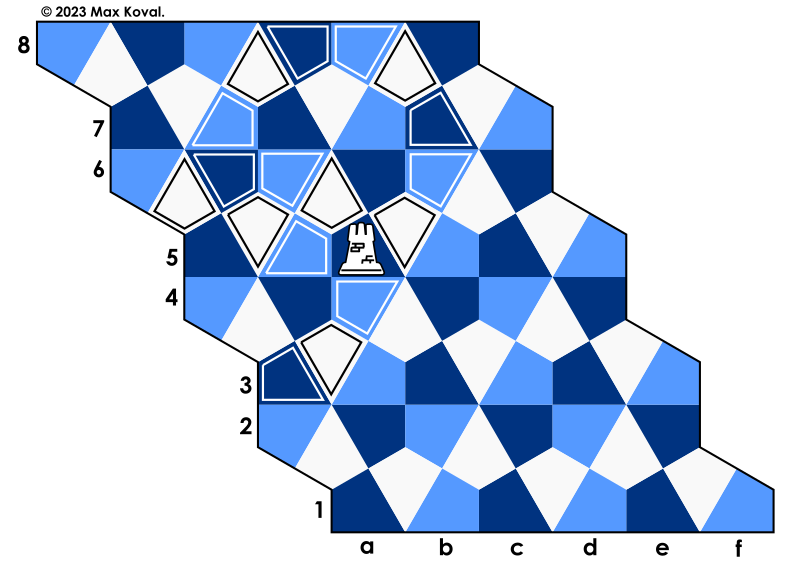Trihexagonal Chess
Trihexagonal Chess is a chess variant for two players developed by Max Koval in 2023. The game is played on an unusually-shaped board of deltoidal trihexagonal tiling (tetrille), and uses an extended chess set with one additional pawn and bishop per side. The ratio between empty and taken cells is 50/50.
The first version of this variant was tested by me in 2021 and was unstable since the white bishop had an immediate opportunity to capture the other bishop from its initial setup. Final board and rules optimisation was made in 2023.
Setup

White: king d1; queen c1; bishop b1, d1/, e1; knight b1/, f1/; rook a1, f1; pawn a2, a2/, b2, c2, c2/, d2, e2, e2/, f2.
Black: king c8; queen d8; bishop b8, c8/, e8; knight a8/, e8/; rook a8, f8; pawn a7, b7/, b7, c7, d7/, d7, e7, f7/, f7.
The way coordinates work is shown below:

To distinguish white cells from gray cells in written notation, they are marked with a slash.
Pieces
Rook
The rook moves an arbitrary number of spaces in any orthogonal direction. This is movement in a circle-alike manner along a series of spaces connected by shared sides; every cell is followed by the next one from the previous cells' outer side. It is interesting to note that b6 can be attacked by a rook in three different ways. The rook cannot make null moves.

Bishop
Similar to the rook, but in any of four possible diagonal directions (left-up: c5, b6, a7...; right-up e5, f6...; etc).

Queen
The queen moves like the rook and bishop combined.
King
The king moves like the queen, but in one cell in any direction only. Castling is technically possible only in the short side. For white it is Kd1-f1/ and Rf1-f2; for black it is Kc8-a8/ and Ra8-a7.
Knight
The knight's move can be defined as one step in an orthogonal direction, and then one step diagonally in an outward direction. As in standard chess, the knight jumps, and the piece that is jumped over is further not affected by it.

Pawn
The pawn's move may look differently depending on which cell it is currently placed; three different types of movement are shown below. Pawn b2 can passively move to b3, c4/ (double step), and attack on a3 or c3; on b3 it can move to b3/ and c4/ and attack on c4 and e4; pawn e2/ can passively move to e2 and f2, and attack on f3/; pawn d5/ can passively move to d6, e6 and attack on e8/. The promotion zone is where all opponent's pieces except pawns are initially placed.

Rules
With all the mentioned exceptions, other rules are the same as in orthodox chess.
Notes
Endgame
A king and its rook can checkmate a lone king; the rook by itself is capable to checkmate a king without assistance.
A king and its bishop cannot checkmate a lone king; three or two bishops can checkmate a lone king without assistance.
A king and its knight can checkmate a lone king.
Scholar's mate: 1.b2c4/ d7d5/ 2.Bb1b3 Be8f6 3.Qc1b1 Qd8e8 4.Bb3xb7#
The board can be constructed in another way where the first row is added to the top row to form three hexagons in addition to nine others.
 This 'user submitted' page is a collaboration between the posting user and the Chess Variant Pages. Registered contributors to the Chess Variant Pages have the ability to post their own works, subject to review and editing by the Chess Variant Pages Editorial Staff.
This 'user submitted' page is a collaboration between the posting user and the Chess Variant Pages. Registered contributors to the Chess Variant Pages have the ability to post their own works, subject to review and editing by the Chess Variant Pages Editorial Staff.
By Max Koval.
Web page created: 2023-04-04. Web page last updated: 2023-06-22
